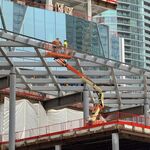44 North
Senior Member
Because the transfer does make a difference despite what the ideologues say. The way to fix this (if we aren't willing to drop the transfer at Kennedy) is to move more traffic to lines that can built without transfers: ie. Eglinton and a reconstituted Sheppard corridor.
Or another idea would be to support similar S(L)RT-style proposals elsewhere in the city. That way the system wont be seen as a unique solution 'foisted' on Scarb. The logic behind the original SRT is sound, and at the time of the TTC's plans for a CLRV line from Kennedy they wanted to do the same at Kipling. Cities like London have embraced a similar mode with their DLR, and it's been continually expanded/branched since its opening. Naturally any potential ridership lost by those wanting to avoid a dreaded transfer could be made up for by a diversion to a longer-haul service like improved GO.
The problem is that outside of Scarb this type of system is completely ignored, even though we've had opportunities. And it oddly seems many who staunchly support the S(L)RT proposal will fight you tooth and nail that such a system can only be built in Scarb. Why is this? IMO Downsview would've been a great terminus and a fantastic opportunity to use a grade-separated light mode to York U and VMC. And ditto for Yonge North between Finch or Steeles and RHC. Some sections could be tunneled, some elevated, some trenched. With grade-separation the capacity is huge, and the line can carry well beyond the threshold of tram-style LRT operation.
But what do we get instead? No proposals for such systems outside of Scarb, but rather schemes for deep bore heavy rail extensions built below fields and 10-lane highways. Vaughan is already planning for an extension of the Spadina line to reach an even newer "centre" 4km north of VMC (Vaughan Mills Centre). And you can be sure the vote-happy Prov will support them on it.
IMO the solution of a subway terminus + transfer to a standalone grade-separate light RT line like the S(L)RT is a good one. But I think these systems are mostly frowned upon because we've already set the precedent of building Cadillac subway extensions elsewhere. Hypothetically if in light of costs/capacity issues the Prov/York Region decides to go back to the drawing board to plan a light metro solution for Yonge instead of a subway, I think the S(L)RT will be seen as much more palatable - to the point where we could cancel SSE and perhaps go back to the SLRT plan.





